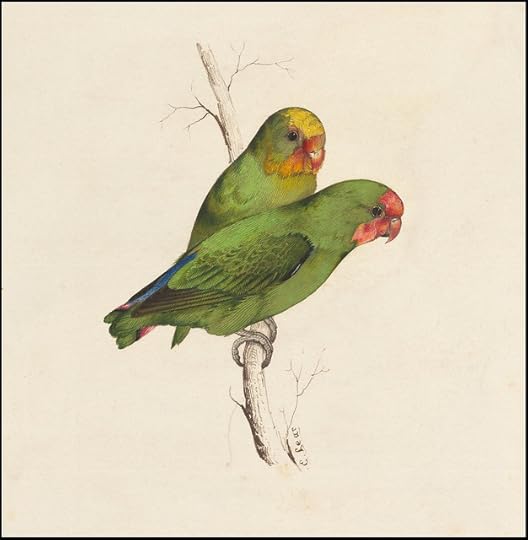Edward Lear and his Birds
Early this year I wrote a piece for the New York Times about the close connection between nineteenth century nonsense verse and the story of global exploration and species discovery.
I wrote particularly about how Edward Lear, author of The Jumblies and other favorite children's books, got his start as an ornithological illustrator. So I am pleased to see this material on Lear from the web site BibliOdyssey. The author is a self-effacing Australian (a phrase that sounds as unlikely as self-effacing Texan) who is basically anonymous. He goes by the name Paul or Peacay, and thinks the attention should go to the work, by other people, that he is celebrating. Click through to savor some of Lear's lovely illustrations:
Lear's Parrots – The Prequel
Edward Lear Sketches of Parrots Relating to 'Illustrations of the Family of Psittacidae, or Parrots' (1832), ca. 1830 (MS Typ 55.9). Houghton Library, Harvard University.
A selection of plates from Lear's published book can be seen in the following post from 2008: The Parrots.
That book is definitely one of my all-time favourite natural history publications; so I was particularly happy to discover Harvard's intriguing collection of preliminary sketches and practice lithographs by Lear.
To quote myself:
"The balance of critical opinion regards Lear's book on parrots to be the finest ever published on that bird family and among the greatest ornithological works ever produced.
It's not just because such an audacious project was successfully completed by so young a character, or that the subject matter was drawn so sensitively and with great scientific accuracy and naturalistic detail, but because the exceptional quality of Lear's plates – drawn, wherever possible, from living specimens – would significantly influence the work of two contemporary artists, John James Audubon and John Gould, perhaps the greatest ornithological illustrators of all time.
Both Audubon and Gould would employ Lear during the 1830s to assist in their projects and it was only failing eyesight that foreshortened Lear's bird illustrating career."
Note: Edward Lear was TWENTY YEARS OLD when his Parrot book was published!!
Lesser sulphur-crested cockatoo : ink, graphite and watercolour drawing. 45 x 30.9 cm.
Drawing cut-out and pasted on leaf.
Inscribed upper left:
"September 1830. Plyctolophus Sulphureus. from a living specimen at Bruton Street."
Two small green birds : hand-coloured lithograph
Macaw : graphite and watercolour drawing. 35.4 x 25.7 cm.
Two small parrots in foliage : ink and watercolour drawing. 37.2 x 55 cm.
Parrot head [red and yellow macaw] : graphite and watercolour drawing. 36.5 x 37 cm
Grey cockatoo : graphite and watercolour drawing. 42.8 x 31.6 cm.

Salmon-crested cockatoo : graphite and watercolour drawing. 54.7 x 36.6 cm.
Drawing for plate 2 in 'Illustrations of the Family of Psittacidae, or Parrots' , 1832.
[Two supplemental pieces of paper [MS Typ 55.9 (22/25a), MS Typ 55.9 (22/25b)] were detached from the sheet for drawing 22 by Lear himself and affixed to drawing 25. One, with colour samples, overlaid the lower right corner of drawing 25; the other was used to extend the feathered crest of the cockatoo beyond the upper edge of the main sheet of drawing 25.]
Small parrot : hand-coloured lithograph. drawing. 55.4 x 36.4 cm.
Green parrot : ink, graphite and watercolour drawing. 33.7 x 29.2 cm.
Inscribed:
"Palaeornis Torquatus. Leila: living at Mr. Vigor's – Chester Terrace. drawn February 1831."

Parrot : graphite and watercolour on lithograph. 54.2 x 36.6 cm.
Inscribed upper left:
"Intended for P. Obscurus, alive at Bruton St. June 1830."

Green and red parrot : ink, graphite and watercolour drawing. 34.3 x 27.4 cm.









